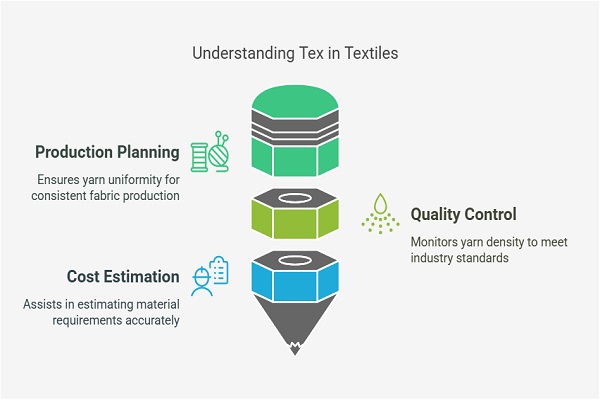Tex Calculator
© Yarn Count Ltd. All rights reserved.
Disclaimer: All tools in the Yarn Count have been reviewed by the relevant spinning industry experts.
The formula for calculating Tex
Tex = Weight in grams (g)÷ (Length in meters (m) )×1000
Where:
- Tex = Yarn count in Tex (the weight of 1000 meters of yarn in grams)
- Weight (g) = Weight of the yarn in grams
- Length (m) = Length of the yarn in meters
Table of Contents
What Is Tex in Textiles?
Tex is a unit of measurement used in the textile industry to express the linear density of yarn. It represents the weight of yarn in grams per 1,000 meters. For example, if 1,000 meters of yarn weighs 20 grams, its tex value is 20.
Tex = (Weight in grams / Length in meters) x 1000
This measurement helps engineers maintain consistency across different yarn types, ensuring product quality and uniformity.
Why Use a Tex Calculator?

A Tex calculator simplifies the process of determining yarn density. Instead of manual calculations, textile professionals can input weight and length to get instant results. This tool is essential for:
- Production Planning: Ensuring yarn uniformity for consistent fabric production.
- Quality Control: Monitoring yarn density to meet industry standards.
- Material Cost Estimation: Calculating required material quantities accurately.
How to Use the Tex Calculator
- Enter Yarn Weight: Input the weight in grams.
- Enter Yarn Length: Input the length in meters.
- Click Calculate: The calculator provides the tex value immediately.
Practical Applications of Tex Measurement
1. Yarn Selection
Manufacturers select yarn based on the tex value to match fabric requirements. For example, heavier fabrics need yarn with higher tex values.
2. Quality Control
Tex values help maintain fabric consistency. Quality control teams regularly check yarn tex to avoid production issues.
3. Cost Estimation
Tex calculators assist in estimating material requirements, preventing waste and reducing costs.

Common Tex Measurement Conversions
- Denier to Tex: Tex = Denier / 9
- Decitex to Tex: Tex = Decitex / 10
- Metric Count to Tex: Tex = 1000 / Metric Count
Tex Calculator Benefits for Textile Engineers
- Accuracy: Reduces errors from manual calculations.
- Efficiency: Saves time in production planning.
- Simplicity: Easy for anyone to use, regardless of technical background.
Tex in Different Textile Applications
- Apparel Manufacturing: Determines yarn type for garments.
- Industrial Textiles: Used in materials like canvas and tarpaulins.
- Technical Textiles: Essential for products like seatbelts and airbags.
Factors Affecting Tex Calculation
- Moisture Content: Yarn weight can change with humidity.
- Material Type: Natural fibers may have inconsistent tex values.
- Measurement Precision: Accurate tools are necessary for reliable results.
Tips for Accurate Tex Calculation
- Use Precise Scales: Ensure accurate yarn weight measurements.
- Measure Correct Lengths: Use calibrated measuring devices.
- Account for Humidity: Condition yarn before weighing if possible.
Conclusion
The Tex calculator is a vital tool for textile engineers, ensuring accurate yarn density measurements. By simplifying calculations, it enhances efficiency, reduces material waste, and supports high-quality textile production. Use this calculator to streamline operations and maintain consistency in your manufacturing process.